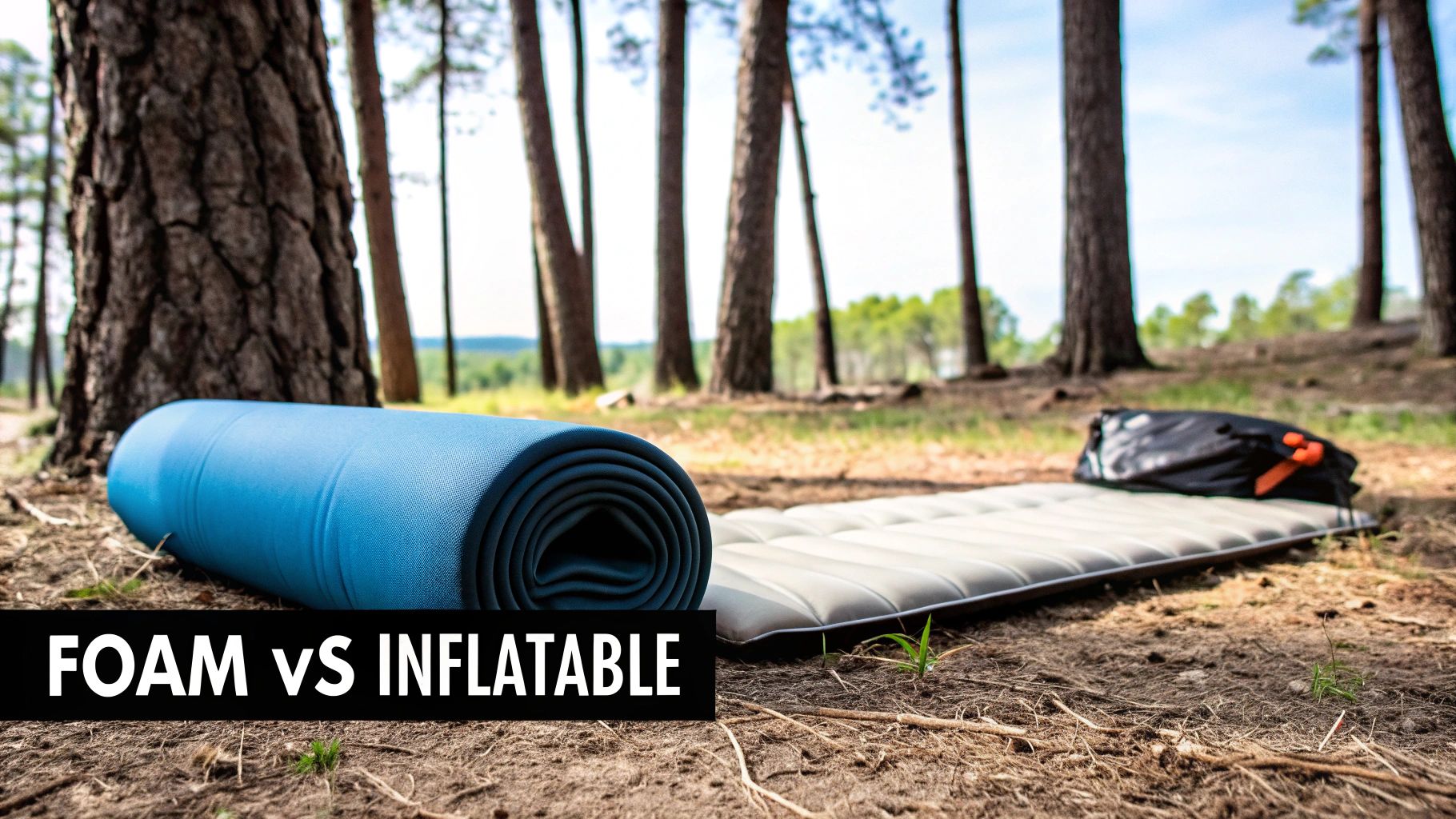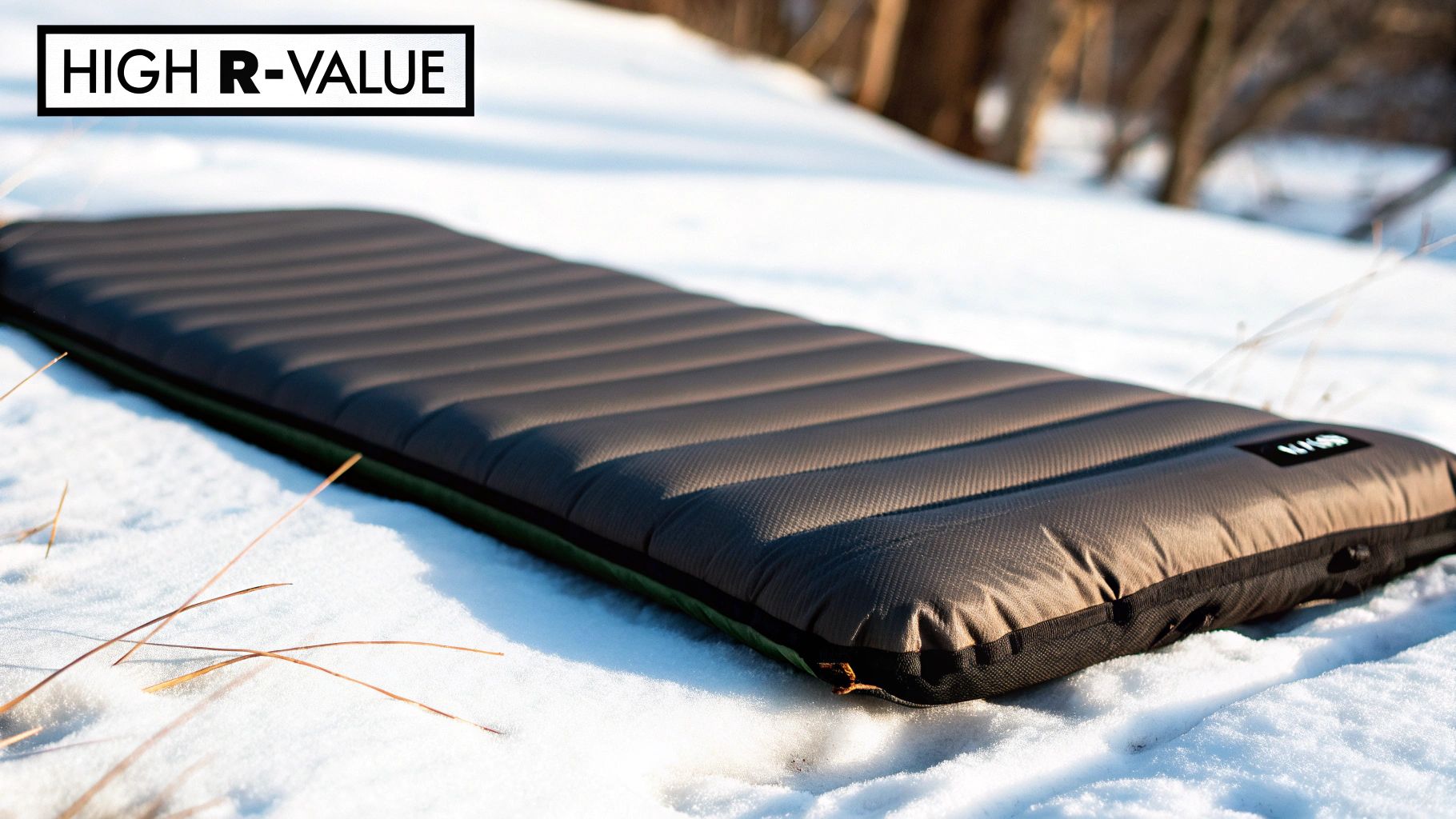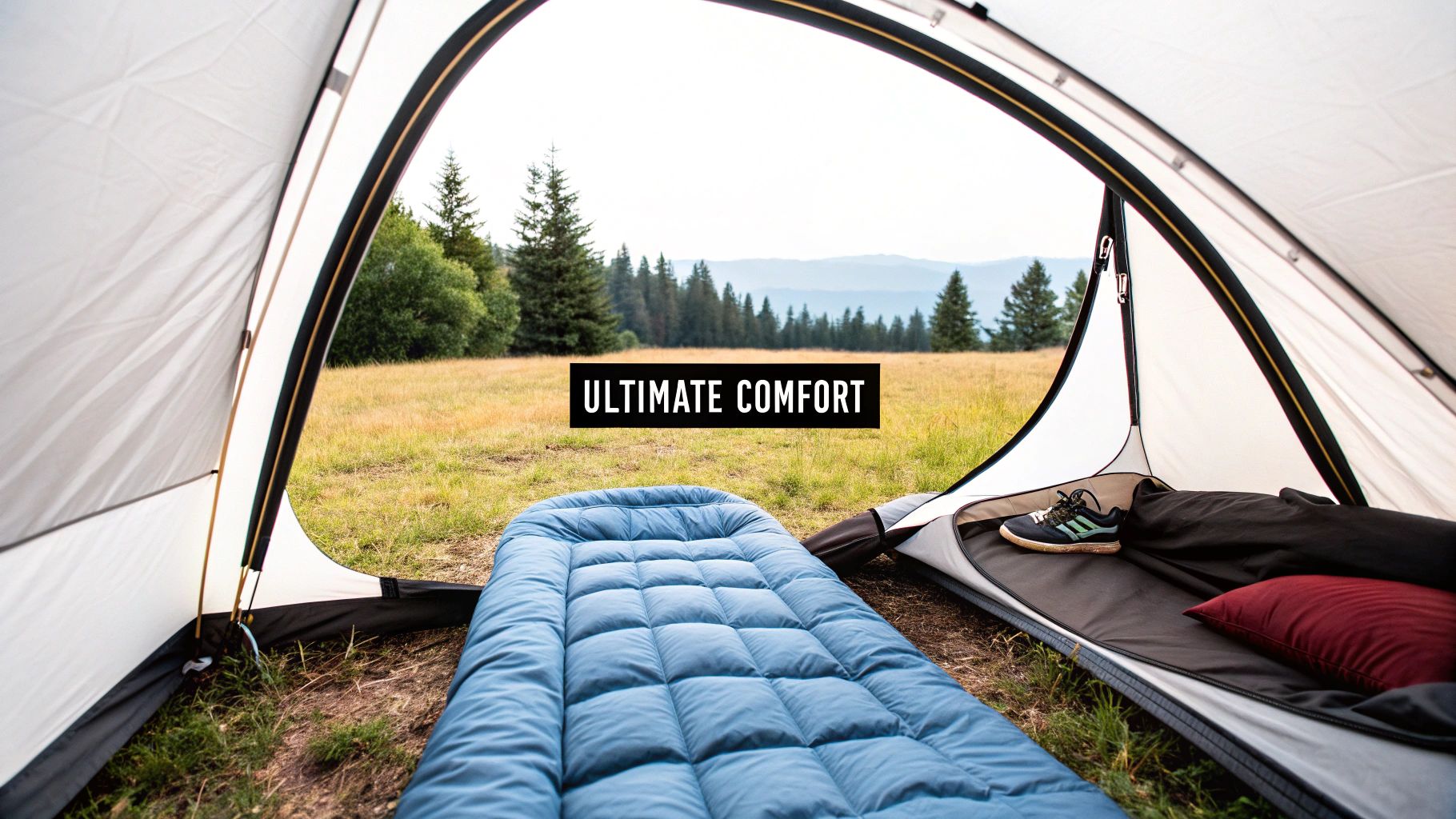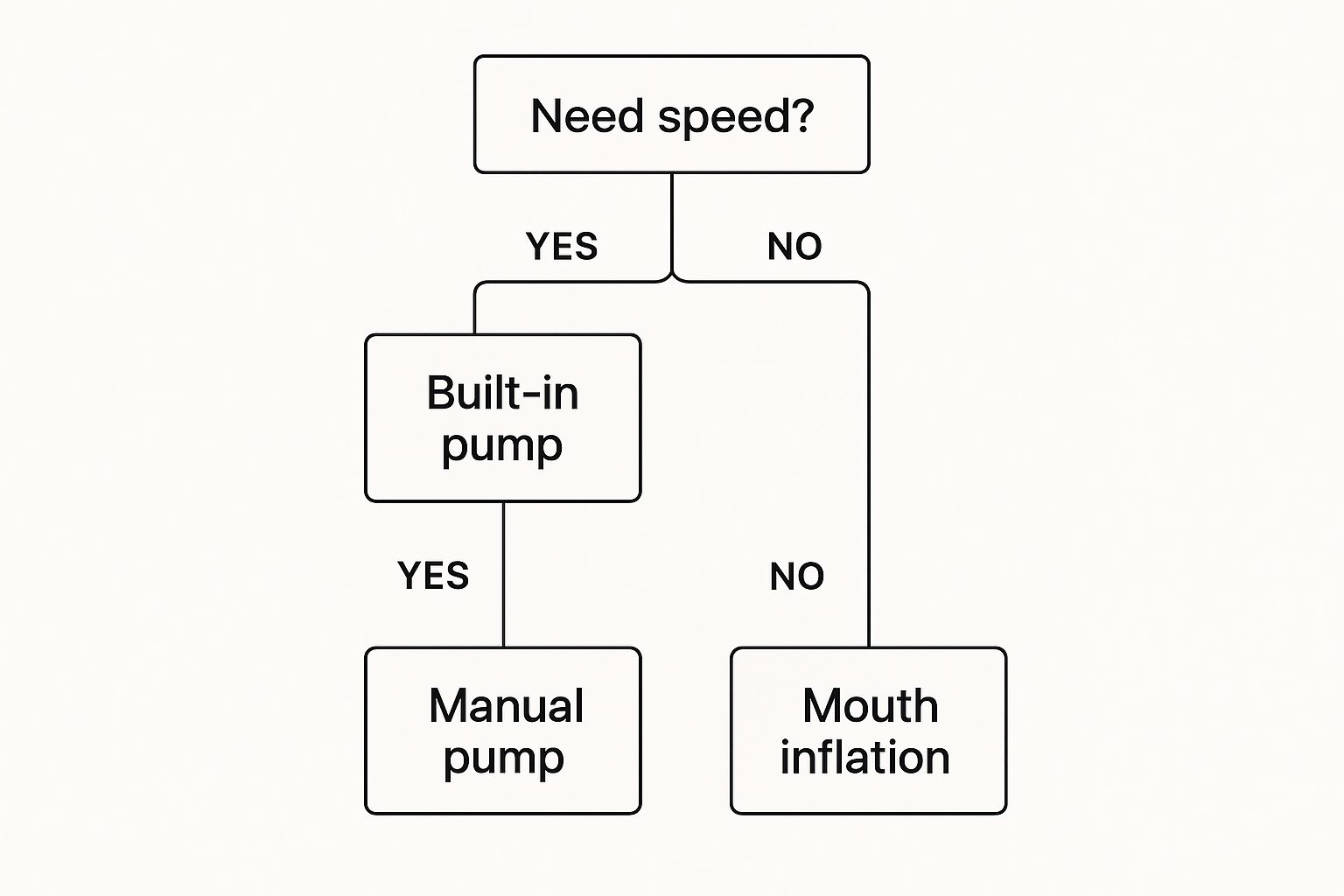With over 10,000 orders
With over 10,000 orders

The best sleeping pad isn't a single "best" model for everyone. It's the one that perfectly balances insulation (R-value), comfort (thickness), and portability (weight and packability) for your specific adventures. Car campers can go for gold with thick, high R-value pads, while backpackers need to be more strategic, choosing a lightweight, compact pad with just enough insulation for the season.

A fantastic day on the trail always starts with a good night's sleep, and your sleeping pad is the unsung hero that makes it happen. It’s so much more than a bit of cushioning; this piece of gear is pulling double duty. First, it insulates you from the cold, hard ground, which sucks body heat away way faster than chilly air ever could. Second, it provides the support your body needs to prevent waking up with sore hips and shoulders.
Choosing the right pad can completely transform your night outdoors, turning it from a test of endurance into a chance to truly rest and recharge for the next day. It's a cornerstone of your sleep system, working hand-in-hand with your sleeping bag to deliver total warmth and comfort.
The quest for the "best" sleeping pad isn't about finding a single product that rules them all. It's about finding the perfect match for your camping style. What works for a thru-hiker obsessing over every single ounce is going to be worlds apart from what a family needs for a weekend car camping trip.
To pick the right one, you need to get familiar with the key factors that set them apart. These are the specs that determine how a pad performs, how it feels, and where it shines.
A sleeping pad's most important function is to keep you warm; although we all like to be comfortable, we can’t be comfortable if we’re cold. An appropriate R-value is the foundation of a good night's sleep outdoors.
This guide is here to break it all down without burying you in technical jargon. We'll give you clear, practical advice to help you navigate the options. Whether you're headed to a local campground or deep into the backcountry, you'll walk away knowing exactly how to choose the perfect foundation for a great night under the stars.
To get you started, the table below gives a quick snapshot of the three main types of sleeping pads you'll find out there. It’s a great way to quickly see which category makes the most sense for you.
| Pad Type | Key Advantage | Key Disadvantage | Best For |
|---|---|---|---|
| Closed-Cell Foam | Unmatched durability and low cost | Bulky and less comfortable | Thru-hikers, budget campers, and as a secondary winter pad. |
| Self-Inflating | Good balance of comfort, insulation, and convenience | Heavier and bulkier than air pads | Car camping and campers who prioritize reliability and ease of use. |
| Air Pad | Excellent comfort and very compact | Can be punctured; often more expensive | Backpackers, side sleepers, and anyone prioritizing comfort and packability. |
Think of this as your starting point. Now, let’s dive deeper into what makes each of these pad types—and their features—tick.

When you start digging into sleeping pads, you’ll see one term pop up more than any other: R-value. It might look a bit technical, but it’s the single most important number for guaranteeing a warm night’s sleep under the stars. Think of it like the insulation in the walls of your house.
Its one and only job is to stop heat from escaping. For a sleeping pad, R-value measures how well it resists your body heat from being sucked away by the cold ground. A higher R-value means more resistance, more insulation, and a much warmer you.
The ground is basically a giant, cold sponge, constantly trying to pull warmth away from your body through a process called conduction. A sleeping bag can’t do much to stop this on its own because your body weight flattens the insulation beneath you, making it pretty much useless. Your sleeping pad is the crucial barrier that stands between you and a cold, sleepless night.
The great thing about the R-value scale is how simple it is—the numbers are additive. If you have a closed-cell foam pad with an R-value of 2.0 and you layer it under an inflatable pad with an R-value of 3.5, your total insulation is now a cozy R-value of 5.5. This stacking trick is a game-changer for anyone venturing out in colder weather.
Quick heads-up: Back in 2020, the outdoor industry adopted a standardized testing method (ASTM F3340-18) for R-values. This was a huge step forward! It means you can now compare pads from different brands and know you're looking at an apples-to-apples measurement of warmth.
So, what do these numbers actually mean when you’re out in the wild? While everyone’s internal thermostat is a little different (some of us are human furnaces, others are always cold), these guidelines are a solid starting point for most campers.
Knowing the scale is one thing, but applying it is what really counts. Getting this choice right can be the difference between a fantastic trip and a miserable one.
Let’s say a backpacker is heading to the Colorado Rockies in late September, where nighttime temps can easily drop below freezing. If they only bring their lightweight summer pad with an R-value of 1.5, they’re going to shiver all night, no matter how good their sleeping bag is. The cold ground will just pull their body heat right through the pad. A much smarter choice would be a pad with an R-value of at least 4.0, which provides the thermal barrier needed to stay warm.
On the flip side, someone camping in the Mojave Desert in May has no reason to haul a heavy, high-R-value winter pad. A minimalist pad with an R-value around 2.0 will provide all the cushion they need without the unnecessary insulation.
At the end of the day, it's all about matching your pad to the coldest ground you expect to sleep on. And when in doubt, it’s always better to be a little too warm than to spend the night shivering. By understanding this one crucial number, you can pick the perfect pad and guarantee yourself a warm, restorative sleep on any adventure.

Once you've wrapped your head around R-value, your next big decision is picking the right type of pad. This is where it gets interesting, because the internal structure of a pad completely changes how it feels and performs on the trail.
Think of it like choosing a vehicle for a road trip. A rugged truck, a balanced SUV, and a sleek sports car will all get you there, but they’re built for very different kinds of journeys. It’s the same with sleeping pads.
The big three are closed-cell foam pads, self-inflating pads, and air pads. Each one has its own personality—a unique set of strengths and, of course, a few trade-offs. The best pad for you is simply the one that aligns with what you value most, whether that’s bombproof reliability, all-around comfort, or shaving every possible ounce from your pack.
The demand for better, more specialized gear is booming. The global market for camping sleeping pads is already valued at about USD 1.36 billion and is expected to climb to USD 2.13 billion by 2033. This growth is all about more people getting outdoors and wanting gear that’s both comfortable and easy to carry.
Closed-cell foam pads are the old-school, classic solution. Their design is genius in its simplicity: a sheet of dense foam filled with tiny, sealed air pockets that do a great job of trapping heat. You just unroll or unfold it, and you're good to go. No fuss, no inflation.
Their biggest selling point is their unwavering durability. You can toss one of these on sharp rocks, pine needles, or gritty dirt without a second thought. There's nothing to puncture and no valves to break, making them the most reliable option out there, period. This toughness, plus their low cost, makes them a favorite for serious thru-hikers and campers on a budget.
But that beautiful simplicity does come at a price.
Closed-cell foam pads make the ultimate backup plan. Even if your main inflatable pad springs a leak, having one of these underneath guarantees you still have that crucial layer of insulation separating you from the cold ground.
Self-inflating pads strike a fantastic balance, blending the best of foam and air into one clever package. Inside their tough fabric shell is a layer of open-cell foam. When you open the valve, this foam naturally expands and pulls air into the pad, doing most of the inflation for you.
This foam-air combo delivers a sweet spot of features that works for a huge range of campers. They're often tougher and more puncture-resistant than air pads, and that internal foam means you’ll still have some insulation even if you get a small leak.
Air pads are the pinnacle of trail comfort and packability. These pads are all about air—there's no foam inside. Instead, they use intricate baffles or air chambers to create a stable, supportive structure. When you let the air out, they pack down incredibly small, often to the size of a Nalgene bottle.
Their main superpower is comfort. Air pads can be 3-4 inches thick (or even more!), providing incredible cushioning that cradles your body. This is a game-changer for side sleepers who need that extra give for their hips and shoulders. Top-tier models use fancy reflective films and baffle designs to crank up the R-value without adding weight. For a deeper dive, check out our full guide on how to choose the best sleeping pad.
The one catch? They can be punctured. A sharp rock or a stray thorn can leave you sleeping on the hard ground. That’s why carrying a patch kit is non-negotiable. While the materials get tougher every year, you still need to be a little careful where you set up camp.
Let’s be honest: the idea of one single “best sleeping pad” is a total myth. The best pad is the one that’s right for you and your adventure. A thick, luxurious pad that’s perfect for a drive-up campsite will feel like a bag of bricks five miles into a backpacking trip.
The real trick is connecting the specs—like R-value and pad type—to how you actually camp. It’s all about figuring out your camping personality and then finding a pad with the features that match.
Let's break down a few common camping styles and see what matters most for each one.
For the backpacker counting every last ounce, the game is all about efficiency. The goal is to move fast and light, which means your gear has to be incredibly streamlined. Comfort is still a factor, but it often comes second to weight and how small the pad packs down.
When your campsite is just a few feet from your car, all the usual rules about weight and size go out the window. Here, comfort is king. The mission is to create a sleep setup so plush and supportive it rivals your bed at home.
The desire for a great night's sleep has fueled a huge market for comfy car camping gear. In fact, the global market for these pads was valued at around USD 1.6 billion and is expected to hit nearly USD 2.8 billion by 2032. This boom is driven by campers wanting bigger, better-insulated, and self-inflating pads.
For car campers, don't be afraid to think bigger. Pairing two single pads together or opting for a duo-specific model can transform a tent into a comfortable backcountry bedroom, perfect for families or couples.
The image below breaks down the different ways to inflate a pad—a key choice for both convenience at the campsite and efficiency on the trail.

Use this as a quick reference to decide if a built-in pump, a separate pump sack, or good old-fashioned lung power is the best fit for you.
When you’re heading into the high, cold places, your sleeping pad becomes more than just a comfort item—it’s a crucial piece of survival gear. Sleeping directly on snow or frozen ground will sap your body heat in a hurry, so you need serious insulation.
To make things even clearer, let's put this all into a simple table. Think of it as a cheat sheet for finding the right pad for your next trip.
| Camping Style | Primary Priority | Recommended Pad Type | Ideal R-Value Range |
|---|---|---|---|
| Ultralight Backpacking | Weight & Packability | Air Pad | 2.5 - 4.0 |
| Car Camping | Comfort & Thickness | Self-Inflating or Large Air Pad | 4.0+ |
| Mountaineering / Winter | Insulation & Reliability | Foam + Air Pad Combo | 6.0+ (Combined) |
| Weekend Getaways | Balanced Comfort & Portability | Self-Inflating or Air Pad | 3.0 - 5.0 |
Ultimately, this table helps you cut through the noise. By identifying how you camp, you can immediately focus on the features that will make the biggest difference for you out in the wild.
Once you’ve settled on the right pad type and R-value for your adventures, it's time to dig into the details. These are the little things that truly separate a good sleeping pad from a great one—the features that shape your comfort and convenience when you're miles from home.
Getting these finer points right is the final step to finding a pad you’ll be happy with for years to come. It’s about ensuring your gear doesn't just look good on a spec sheet, but actually feels right when you’re out there using it.
For a lot of us, especially side sleepers, pad thickness is the single most important factor for a good night's sleep. When you’re on your side, your body weight gets concentrated on your hips and shoulders. On a thinner pad, it’s all too easy to “bottom out” and feel the hard, cold ground right through the pad.
A thicker pad—we’re talking anything over 3 inches—gives you that extra cushion, allowing those pressure points to sink in without hitting rock bottom. This one feature can completely change your sleep quality, making it a must-have for anyone who's ever woken up with sore hips. Back sleepers can usually get by with a bit less, but who's going to complain about extra plushness?
Here it is: the classic backcountry dilemma. For anyone who has to carry their home on their back, the trade-off between weight and packed size is always front and center. The best sleeping pad is one you don't even notice in your pack. Modern air pads have worked wonders here, packing down to the size of a Nalgene bottle while offering unbelievable comfort.
But this magic usually comes at a price. Ultralight materials can be more fragile, and every feature that adds comfort or warmth also adds ounces. It’s all about finding your balance:
A sleeping pad that pops in the middle of the night is worse than useless. The toughness of a pad’s fabric is measured in denier (D), a number that tells you how thick the fibers are. A higher number, like 75D, means you’ve got a rugged, puncture-resistant fabric. A lower number, like 20D, means it’s lighter but needs more gentle handling.
If you're tough on your gear or frequently camp on rocky, unforgiving ground, choosing a pad with a higher denier fabric is a smart move. It adds a bit of weight but buys you a whole lot of peace of mind.
It might seem like a tiny detail, but the valve system can make or break your experience with a pad. Older pads with those simple twist valves were slow to inflate and even slower to deflate.
Thankfully, modern pads have much smarter designs:
Last but not least, think about the shape and sound of your pad. Most pads are either rectangular or mummy-shaped. Rectangular pads give you more room to toss and turn, while mummy pads taper at the feet to cut down on weight and bulk.
Some high-performance ultralight pads use crinkly, reflective materials inside to boost their warmth. While it works, it can also sound like you’re trying to sleep on a giant bag of potato chips. If you’re a light sleeper, finding a quieter pad might be your top priority. You can also pair your pad with a foam layer for extra warmth and to see firsthand how to insulate a tent for winter camping.
Even after you've found the perfect sleeping pad, a few questions are bound to pop up once you start putting it to the test. From basic care to those dreaded trailside repairs, knowing how to handle the common stuff will keep your pad in great shape and ensure you're always set for a comfortable night.
We've rounded up some of the most frequent questions we hear from campers. Here are some straightforward answers to help you get the most out of your gear.
A little bit of proper care goes a long way in extending the life of your sleeping pad. After any trip, it’s probably caked with a mix of dirt, sunscreen, and body oils. If you let that stuff sit, it can slowly degrade the fabric over time.
Cleaning is super simple. For any type of pad, just grab a damp cloth with a little mild soap and give the surface a gentle wipe-down. The key is to avoid harsh detergents or chemical cleaners, as they can strip away the pad's protective coatings. Let it air dry completely before you even think about packing it away.
Storage is where a lot of people go wrong. For air pads and self-inflating models, keeping them compressed for long periods is a recipe for trouble.
The best way to store both is either loosely rolled or laid out flat—maybe slide it under a bed or tuck it behind the couch. And always leave the valve open! This lets the foam stay expanded and allows any moisture from your breath to escape, which is key to preventing mildew.
This is a huge and surprisingly common misconception. It's easy to think a beefy, winter-rated sleeping bag can make up for a pad with a low R-value, but that's just not how it works. Your sleeping bag keeps you warm with its loft—all that fluffy insulation that traps air.
But the moment you lie down, your body weight crushes all that insulation beneath you, making it pretty much useless. Without that loft, there's almost nothing between you and the cold ground.
Think of it this way: your sleeping bag insulates you from the cold air, but your sleeping pad is what insulates you from the cold ground. Both are critical pieces of the puzzle, and one can't do the other's job.
The ground is a massive heat sink, constantly pulling warmth from your body through a process called conduction. Your sleeping pad is the thermal barrier that stops this heat loss cold. That’s why matching your pad’s R-value to the conditions you’ll be sleeping in is non-negotiable for staying warm. Even the world's best sleeping bag won't stop the shivers if your pad isn't up to the task.
To learn more about building out your entire sleep system, check out our guide on how to get some good ZZZs during camping.
Waking up on the cold, hard ground because your pad deflated is a camper's nightmare. The good news is that a simple puncture is an easy fix—if you're prepared. This is exactly why you should always carry the patch kit that came with your pad or a dedicated aftermarket one.
First, you have to find the leak, which can be the trickiest part. If you're lucky enough to be near a creek or lake, the easiest way is to inflate the pad and submerge it section by section, watching for a telltale stream of bubbles.
No water nearby? No problem. Just mix up a little soap and water, wipe it onto the pad's surface, and look for the spot where new bubbles start to form. Once you’ve located the culprit:
The explosion in outdoor recreation has fueled a huge market for reliable gear, with the specialized segment for lightweight backpacking pads already valued at around USD 500 million. As more people head outside, the demand for durable, field-repairable equipment is only going to climb.
Ready to find the perfect foundation for your sleep system? The engineers at Trekology have designed a range of sleeping pads that blend trail-ready performance with exceptional comfort. Explore our collection and find the ideal pad for your next adventure at https://trekology.com.
{"one"=>"Select 2 or 3 items to compare", "other"=>"{{ count }} of 3 items selected"}
Leave a comment